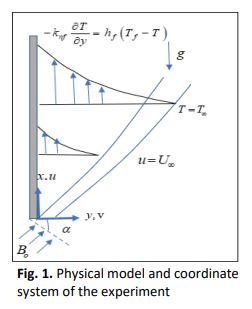Investigation of Nanoparticles Shape Effects on Aligned MHD Casson Nanofluid Flow and Heat Transfer with Convective Boundary Condition
DOI:
https://doi.org/10.37934/arfmts.91.1.155171Keywords:
Aligned MHD, Natural Convective Boundary Condition, Casson Nanofluid, Vertical Plate, Nanoparticles ShapeAbstract
This study focuses on the investigation of aligned MHD natural convection flow and heat transfer of a Casson nanofluid past a vertical plate with convective boundary condition. Casson nanofluid are found in a wide range of commercial and technological applications, including dissolved polymers, biological solutions, paints, asphalts, and glues. The governing partial differential equations (PDE) is transformed to ordinary differential equations (ODE) by using similarity transformation. Keller box method is employed to numerically solve the transformed partial differential equations and then the system is solved by Fortran programming. The results for both the velocity and temperature profiles of Casson nanofluid as well as the skin friction and Nusselt number that are affected by nanoparticles shape factor considering parameters aligned angle of magnetic, interaction of magnetic field, volume fraction of nanoparticles, Local Grashof number, Casson parameter and Biot number are presented graphically and in tabulated form. It is also found that the velocity increases while the temperature decreases when the aligned angle of magnetic, interaction of magnetic field, Casson parameter and Local Grashof number increase. The skin friction and Nusselt number increases for all parameters except for Casson nanofluid parameter. For convective boundary condition, Biot number increases when both velocity and temperature profiles increase. The nanoparticles shape of laminar has the highest velocity and temperature while the spherical shape has the lowest for all parameters.
Downloads

































